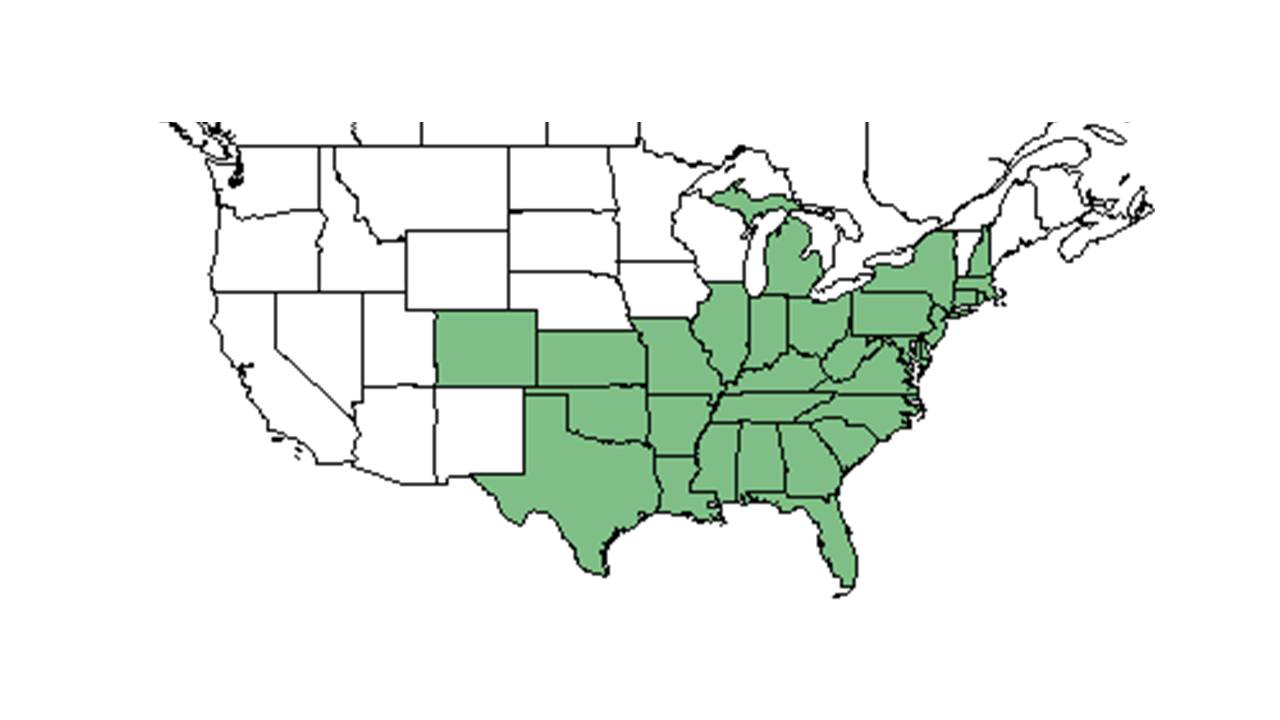Difference between revisions of "Desmodium obtusum"
(→References and notes) |
(→Ecology) |
||
| Line 24: | Line 24: | ||
==Ecology== | ==Ecology== | ||
===Habitat=== <!--Natural communities, human disturbed habitats, topography, hydrology, soils, light, fire regime requirements for removal of competition, etc.--> | ===Habitat=== <!--Natural communities, human disturbed habitats, topography, hydrology, soils, light, fire regime requirements for removal of competition, etc.--> | ||
| − | + | It is distributed widely throughout the eastern U.S. and southern Great Plains (NRCS Plants Database). Frequently burned longleaf and shortleaf pine-oak-hickory upland native and old-field communities (Ultisols) (Cushwa 1970, FSU Herbarium), longleaf pine-turkey oak sandhills (Entisols), longleaf and slash pine flatwoods (Spodosols), and limestone outcrops (FSU Herbarium). It is fire-tolerant (Cushwa 1970). Occurs in both native (never plowed) areas and areas with recent recent soil disturbance. Seems to have ruderal tendencies. Occurs on a wide range off soils from loamy sand to to clayey soils and in sites ranging from xeric to moist (FSU Herabarium). | |
===Phenology=== <!--Timing off flowering, fruiting, seed dispersal, and environmental triggers. Cite PanFlora website if appropriate: http://www.gilnelson.com/PanFlora/ --> | ===Phenology=== <!--Timing off flowering, fruiting, seed dispersal, and environmental triggers. Cite PanFlora website if appropriate: http://www.gilnelson.com/PanFlora/ --> | ||
In the southeastern coastal plain it flowers in September and October and fruits September-November (FSU Herbarium). | In the southeastern coastal plain it flowers in September and October and fruits September-November (FSU Herbarium). | ||
| Line 30: | Line 30: | ||
===Seed bank and germination=== | ===Seed bank and germination=== | ||
===Fire ecology=== <!--Fire tolerance, fire dependence, adaptive fire responses--> | ===Fire ecology=== <!--Fire tolerance, fire dependence, adaptive fire responses--> | ||
| − | + | It thrives in frequently burned (1-2 year interval) habitats and occurs primarily in high-light environments but can also tolerate partial shade (FSU Herbarium). | |
===Pollination=== | ===Pollination=== | ||
===Use by animals=== <!--Herbivory, granivory, insect hosting, etc.--> | ===Use by animals=== <!--Herbivory, granivory, insect hosting, etc.--> | ||
Revision as of 10:10, 13 July 2015
| Desmodium obtusum | |
|---|---|

| |
| Photo taken by Kevin Robertson | |
| Scientific classification | |
| Kingdom: | Plantae |
| Division: | Magnoliophyta - Flowering plants |
| Class: | Magnoliopsida – Dicotyledons |
| Order: | Fabales |
| Family: | Fabaceae ⁄ Leguminosae |
| Genus: | Desmodium |
| Species: | D. obtusum |
| Binomial name | |
| Desmodium obtusum (Muhl. ex Willd.) DC. | |

| |
| Natural range of Desmodium obtusum from USDA NRCS Plants Database. | |
Contents
Description
Common Name: stiff ticktrefoil
Distribution
Ecology
Habitat
It is distributed widely throughout the eastern U.S. and southern Great Plains (NRCS Plants Database). Frequently burned longleaf and shortleaf pine-oak-hickory upland native and old-field communities (Ultisols) (Cushwa 1970, FSU Herbarium), longleaf pine-turkey oak sandhills (Entisols), longleaf and slash pine flatwoods (Spodosols), and limestone outcrops (FSU Herbarium). It is fire-tolerant (Cushwa 1970). Occurs in both native (never plowed) areas and areas with recent recent soil disturbance. Seems to have ruderal tendencies. Occurs on a wide range off soils from loamy sand to to clayey soils and in sites ranging from xeric to moist (FSU Herabarium).
Phenology
In the southeastern coastal plain it flowers in September and October and fruits September-November (FSU Herbarium).
Seed dispersal
Seed bank and germination
Fire ecology
It thrives in frequently burned (1-2 year interval) habitats and occurs primarily in high-light environments but can also tolerate partial shade (FSU Herbarium).
Pollination
Use by animals
Diseases and parasites
Conservation and Management
Cultivation and restoration
Photo Gallery
References and notes
Florida State University Robert K. Godfrey Herbarium database. URL: http://herbarium.bio.fsu.edu. Last accessed: June 2014.
Collectors: R.K. Godfrey, John Morrill, Loran C. Anderson, A. F. Clewell, R. Kral, J. P. Gillespie; D. C. Hunt, R. Komarek, Sidney McDaniel, Samuel B. Jones, Jr., Harry E. Ahles, J A Duke; Charles S. Wallis, William B. Fox, Lloyd H. Shinners, and Eula Whitehouse.
States and Counties: Alabama: Greene and Macon. Florida: Calhoun, Escambia, Franklin, Jackson, Leon, Madison, and Wakulla. Georgia: Baker, Colquitt, Grady, and Thomas. Louisiana: Bossier. Mississippi: Lamar. North Carolina: Mecklenburg and Robeson. Oklahoma: Sequoyah. Texas: Freestone.
NRCS Plants Database http://plants.usda.gov/java
Cushwa, C. T. (1970). Response of legumes to prescribed burns in loblolly pine stands of the South Carolina Piedmont. Asheville, NC, USDA Forest Service.